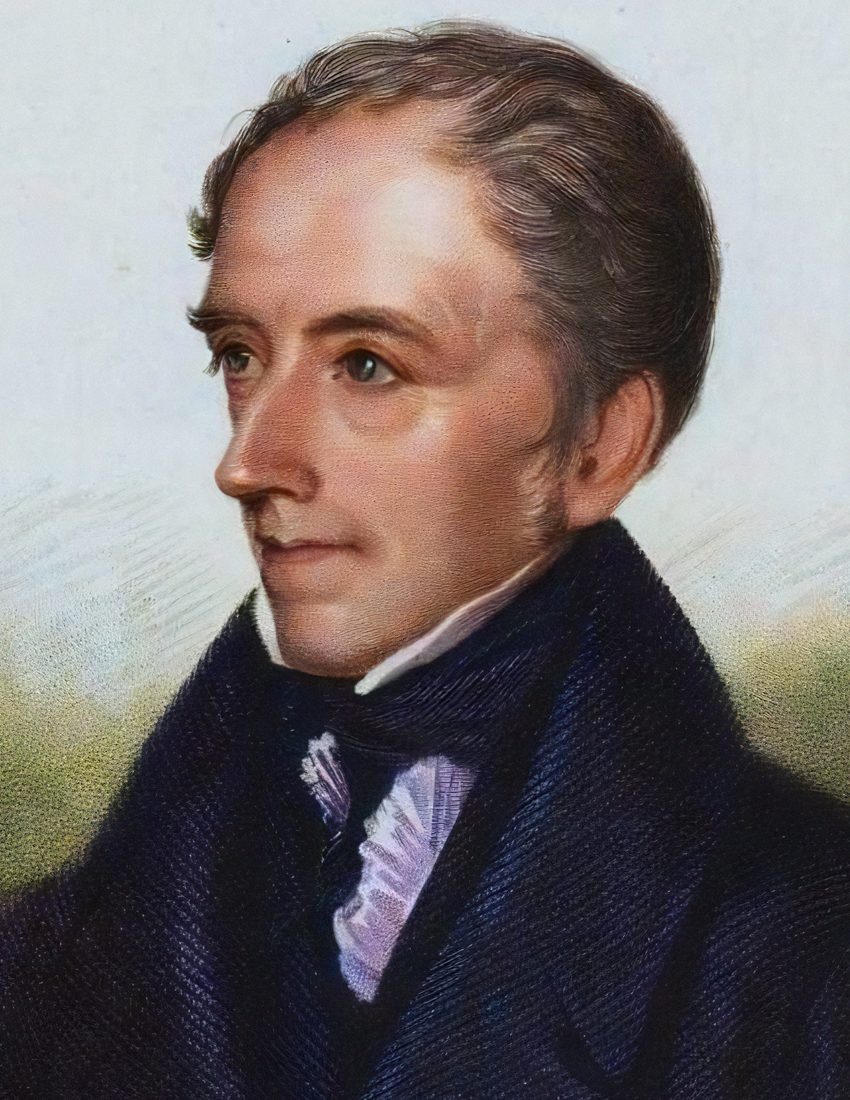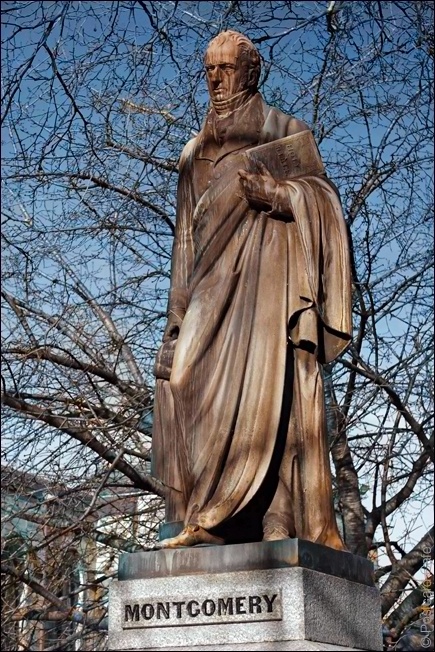Born: November 4, 1771, Irvine, Ayrshire, Scotland.
Died: April 30, 1854, Mount, Sheffield, England.
James Montgomery

Hymns by James Montgomery
A Monument to Montgomery’s Legacy
In 1861, Sheffield honored its beloved poet with a grand monument. Designed by John Bell and funded by public subscription, the £1000 memorial stood as a memorial to Montgomery’s impact. The granite pedestal bore a touching tribute: “Here lies interred, beloved by all who knew him, the Christian poet, patriot, and philanthropist.” It proclaimed that through his writings, Montgomery continued to speak even after death.
Time took its toll on the statue, and in 1971 it found a new home in Sheffield Cathedral’s precincts. There, alongside a memorial window, it continues to remind visitors of the man whose hymns still echo in churches worldwide. Montgomery’s words, etched in stone and glass, live on—a fitting tribute to a poet whose verses touched countless hearts.
James Montgomery: From Radical Editor to Beloved Hymn Writer
On a warm summer’s day in the late 1700s, a group of young boys gathered under the shade of a sprawling oak tree. Their teacher, hoping to inspire some appreciation for literature, began to read from Robert Blair’s “The Grave.” Most of the boys fidgeted restlessly, their minds wandering to thoughts of play and mischief. But one boy sat transfixed, his eyes wide with wonder. James Montgomery, deemed a lackluster student by his frustrated instructors, felt something awaken within him.
That day marked a turning point for young James. The poetic fervor ignited by Blair’s words would not be extinguished. While his teachers lamented his poor academic performance, James secretly filled page after page with verse. By his tenth year, an entire volume of poetry flowed from his pen. Little did his despairing educators know that their “indifferent scholar” would one day pen hymns sung by millions, his words echoing through churches across the globe for centuries to come.
From Moravian Roots to Poetic Blossoming
Born in 1771 in the Scottish town of Irvine, James Montgomery’s early life was steeped in the devout traditions of his Moravian missionary parents. At just six years old, he was sent to the Moravian school at Fulneck, near Leeds, where his academic struggles and poetic awakening would unfold.
The strict religious education at Fulneck, while challenging for young James, provided a rich tapestry of spiritual themes that would later infuse his writings. His early poems and hymns, modeled after the Moravian Hymn-Book, laid the foundation for his future contributions to Christian worship.
Despite his teachers’ doubts, Montgomery’s poetic gift continued to flourish. Even when sent to work in a huckster’s shop in Mirfield at the age of fifteen, he found moments to craft verse amidst his daily duties. It was during this period that he penned his paraphrase of the 113th Psalm, “Servants of God! in joyful lays,” an early indication of his ability to weave biblical themes into powerful, accessible language.
From Humble Beginnings to Editorial Acclaim
Montgomery’s path to literary success took an unexpected turn when he moved to Sheffield in 1792. Employed by Joseph Gales, printer and editor of The Sheffield Register, Montgomery soon found himself at the helm of his own newspaper, The Sheffield Iris. This role, which he would hold for over three decades, provided a platform for his growing voice and social conscience.
Radical Voice: Montgomery’s Editorial Courage
Montgomery’s editorial career was marked by both triumph and tribulation. His outspoken views on social and political issues twice landed him in prison on charges of sedition. Yet even behind bars, his creative spirit flourished. The publication of “Prison Amusements” in 1797 transformed his hardship into a wellspring of poetic expression.
As the years passed, Montgomery’s writing increasingly focused on matters of faith and social justice. His poem “The West Indies,” written to commemorate the abolition of the slave trade, exemplified his ability to weave spiritual themes with a passionate call for human dignity.
A Divine Collaboration: Montgomery and Cotterill
It was in the realm of hymnody that Montgomery truly found his calling, and where he himself believed his legacy would endure. A pivotal moment in his journey came through an unexpected collaboration with Reverend James Cotterill of St Paul’s Chapel in Sheffield.
Cotterill had published “A Selection of Psalms and Hymns Adapted to the Services of the Church of England” in 1810, but found his new parishioners reluctant to embrace it. Seeking to improve the collection, Cotterill turned to Montgomery for assistance. This partnership would prove transformative for both men and for the future of English hymnody.
Together, they revised and expanded Cotterill’s collection, with Montgomery contributing several of his own compositions. Their work culminated in a new edition published in 1820, which not only met with the approval of the Archbishop of York but also won over the previously resistant congregation of St Paul’s.
This collaboration marked a turning point in Montgomery’s career as a hymn writer. It provided a wider platform for his work and solidified his reputation as a skilled composer of sacred verse. The success of this venture led to the publication of numerous hymn collections, establishing Montgomery as a central figure in the world of Christian worship music.
Hymns that Shaped Christian Worship
Montgomery’s hymns, born from this fruitful collaboration and his own deep faith, quickly gained popularity across denominations. Rich in biblical imagery and emotional depth, they struck a chord with worshippers far beyond the confines of Sheffield.
Among his most enduring works are “Angels from the Realms of Glory,” “Hail to the Lord’s Anointed,” and “Prayer is the Soul’s Sincere Desire.” These hymns continue to be sung in churches worldwide, a powerful demonstration of Montgomery’s gift for capturing profound spiritual truths in accessible, poetic language.
Montgomery’s own prediction about his legacy proved prescient. While his poetry and editorial work were significant in their own right, it is indeed his hymns that have secured his place in history. His ability to blend doctrinal depth with poetic beauty created a body of work that has stood the test of time, continuing to inspire and uplift generations of worshippers.
Enduring Impact: Montgomery’s Literary and Spiritual Legacy
Today, Montgomery’s influence persists in hymnals and poetry collections around the world. His life stands as a powerful reminder that great art can spring from unexpected sources, and that words penned in faith can continue to uplift and inspire long after their author has departed.
James Montgomery’s unique blend of poetic skill, spiritual depth, and social conscience continues to enrich Christian worship across the globe. As congregations sing his hymns today, they join a chorus that spans centuries, giving voice to the timeless truths that Montgomery so eloquently expressed. The once-struggling student, through his divine collaboration and personal conviction, has left an indelible mark on the landscape of Christian hymnody, proving that true talent often flourishes in the most unlikely of places.


